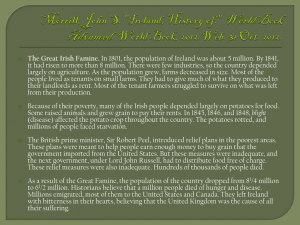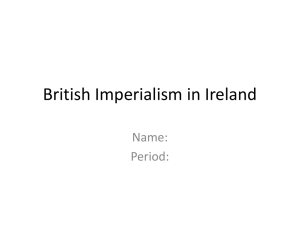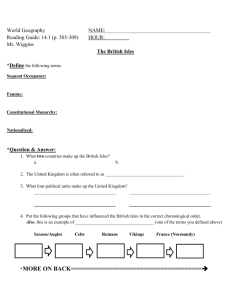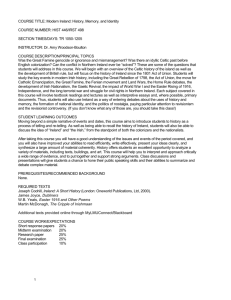The Great Irish Potato Famine
advertisement
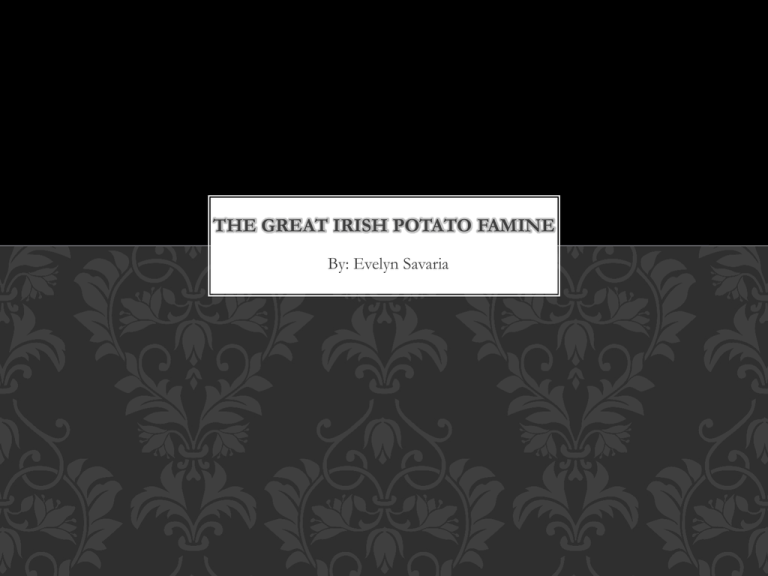
THE GREAT IRISH POTATO FAMINE By: Evelyn Savaria OVERVIEW • • • • • • • • • • Background Information Religious Persecution The Famine Corn Laws Poor Act of 1883 Workhouses Irish Struggles “Relief ” Crime & Violence Conclusion & the Effect of the Famine BACKGROUND • • • • • Between the years 1169 and 1541 England attempts to conquer Ireland King Henry VIII of England declares himself King of Ireland. Protestant King William of Orange defeats the Irish Catholics in 1690. Act of Union of 1801 Ireland was given a small number of representatives in Britain’s parliament. THE FAMINE • The Great Potato Famine started around 1845. • It is estimated that around 1.1 million died and that 2 million emigrated. • The Irish peasants were forced to heavily depend on potatoes by England’s past actions. RELIGIOUS PERSECUTION • 80% of Ireland’s population was Catholic • Catholics didn’t have the same rights as Protestants. • Penal Laws: Catholics were forbidden to vote, hold political office, participate in certain trades/professions, carry or own firearms, or give their children a “Catholic Education.” • Catholic Emancipation in 1829 CORN LAWS • England refused to repeal the Corn Laws. • The Corn Laws were to protect the price of Britain’s homegrown grain. • Heavy tax on imported grain strained relief efforts in Ireland. • These taxes guaranteed a profit for farmers and merchants; boosted economy. POOR LAW ACT OF 1838 & WORKHOUSES • Ireland’s 32 counties were subdivided into 130 Poor Law Unions. • More Workhouses established and held 200-2,000 people. • Families were separated. • Man and boys subjected to hard labor. • People entered voluntarily, but couldn’t leave the grounds or quit without permission. IRISH STRUGGLES • Soon after being conquered, English protestants were given Irish land to encourage colonization. • By 1714 only 7% of the land in Ireland was owned by Catholics. • The Irish were forced into a serfdom-esque situation. “RELIEF” • Since the Irish were viewed as violent, barbaric and immoral people with “dependence on government [the relief programs put in place by England were] more concerned with fostering change than saving lives.” (Kelly 4). • Board of Works, Act of Uniformity, and Test Acts also limited Catholic power while “contributing relief ” to the Irish people. • Laissez-faire excuse CRIME &VIOLENCE • Police could be found on “every part of the island, on every road, in every village, even on the farm land, and on the seashore, and on the little islands which lie out in the sea” (Sommerville 28). • High crime rates & prejudiced judicial system. CONCLUSION & EFFECT OF THE FAMINE • By the time the famine struck, Ireland was already in a state of poverty. • Southern Ireland finally gets Independence in 2008. • Today the famine is used to incite independence rallies in Northern Ireland. Potato Famine memorial in Dublin, Ireland. WORKS CITED • Kelly, John. The Graves Are Walking: The Great Famine and the Saga of the Irish People. New York, NY: Picador, 2013. • Bartoletti, Susan Campbell. Black Potatoes: The Story of the Great Irish Famine, 1845-1850. Boston, MA: Houghton Mifflin Company, 2001. • Sommerville, Alexander. Letters from Ireland during the Famine of 1847.Edited by K.D.M Snell. Dublin, Ireland: Irish Academic Press, 1994. PICTURE SOURCES • http://mang0tang0.edublogs.org/files/2010/05/famine1.gif • • • • • • • http://ts1.mm.bing.net/th?id=HN.608035311862220602&w=129&h=181&c=7&rs=1&pid=1.7 http://www.teara.govt.nz/files/a3985pc.jpg http://www.workhouses.org.uk/Clifden/Clifden1.jpg http://ts3.mm.bing.net/th?id=HN.607986508157027206&pid=1.7 http://www.tcd.ie/history/assets/img/postgraduate/modern-irish/famine.jpg http://www.britannica.com/blogs/wp-content/uploads/2009/09/potato-famine.jpg http://images.rarenewspapers.com/ebayimgs/8.d10.2012/image001.jpg • http://1.bp.blogspot.com/-IXMVvAXzUL4/UTCS4P8hChI/AAAAAAAAFSU/KA9oPX4E9GM/s1600/1-irish-potatofamine-1847-granger.jpg http://www.mullocksauctions.co.uk/wmsimages/Hist-27May10/93.jpg •





